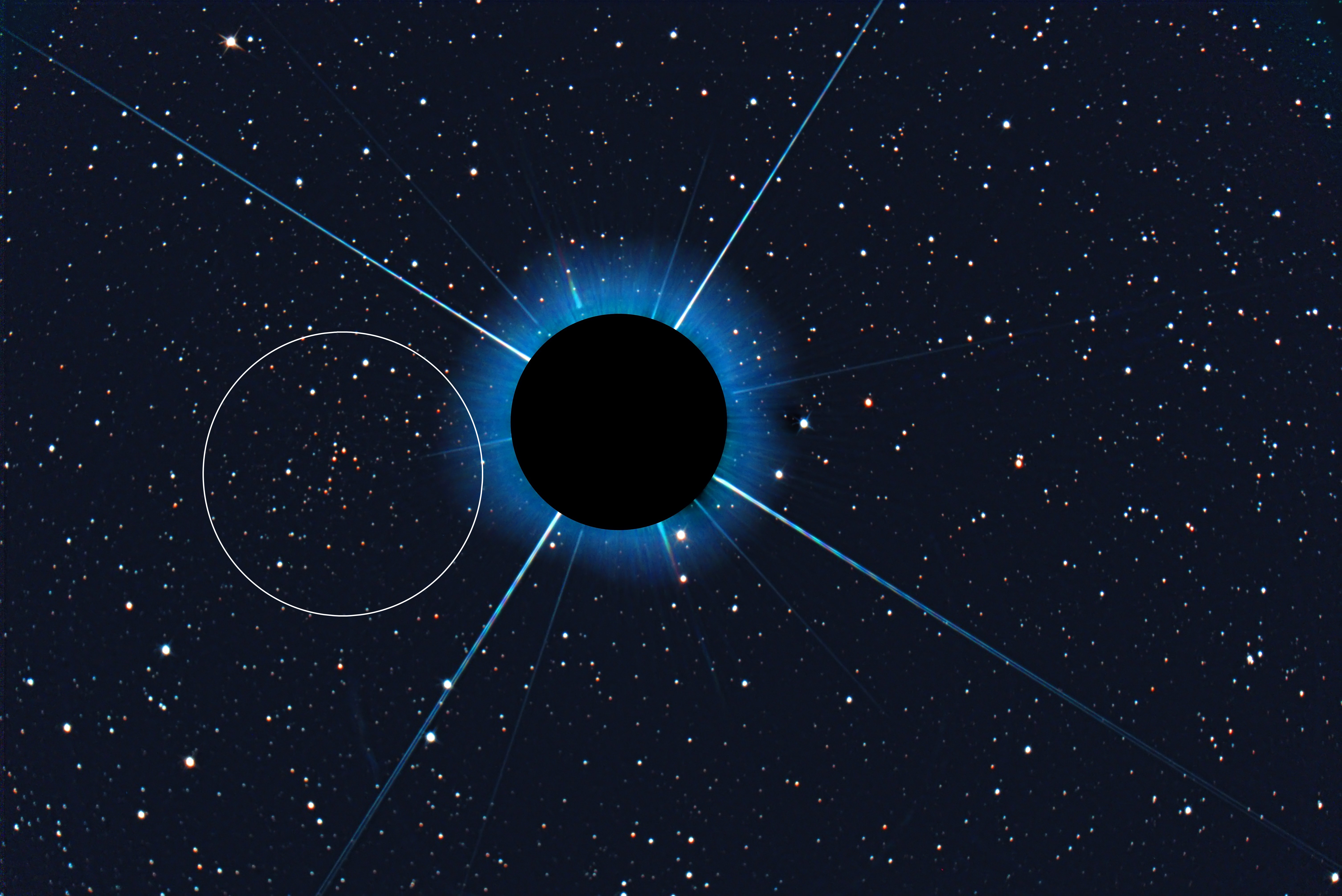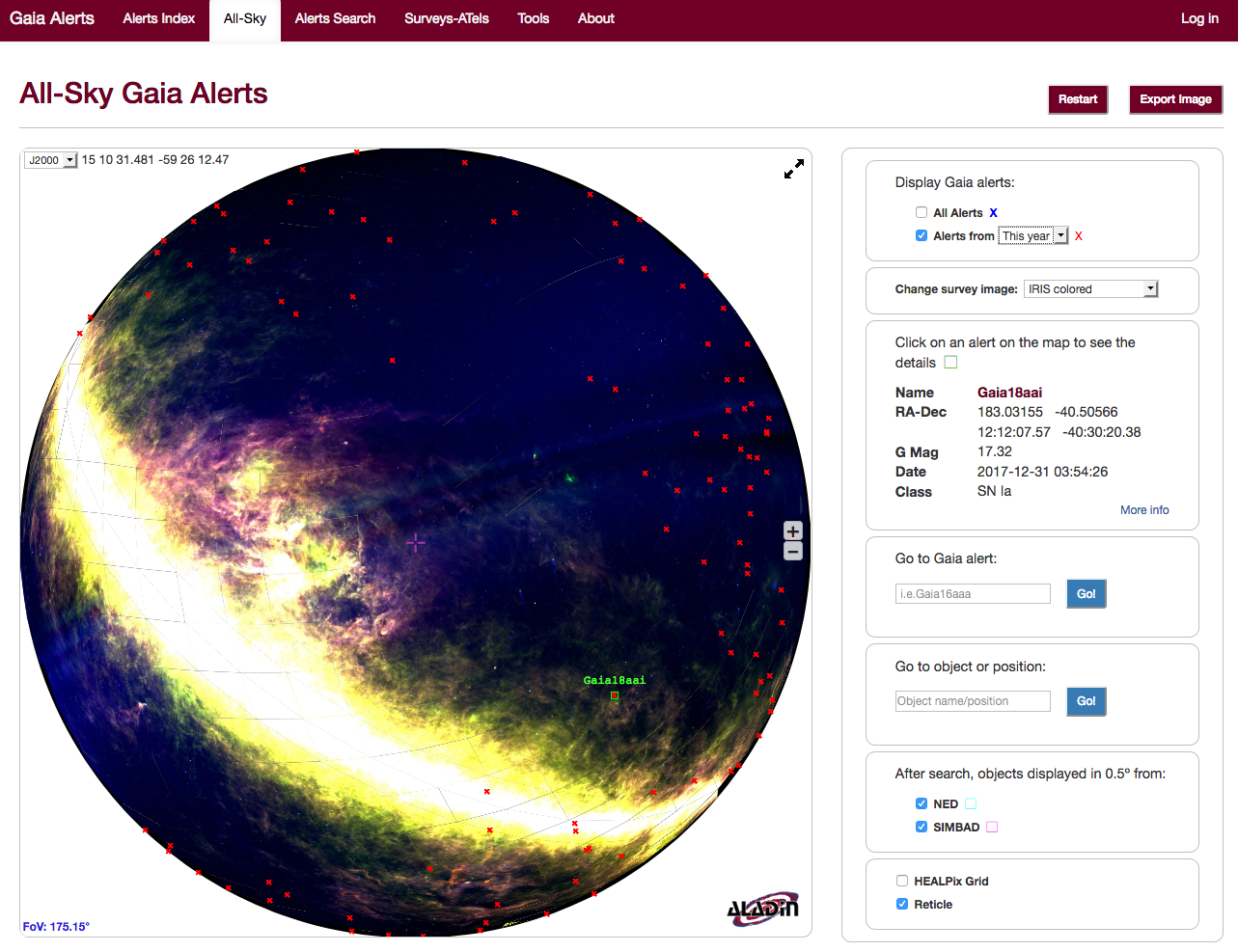IoW_20180129 - Gaia
Image of the Week |
Following-up on Gaia |
|
Gaia 1 cluster image taken from Karlsruhe (Germany) by Harald Kaiser using a 30-cm telescope. The bright, central blob in the centre of the image is Sirius.(Image credit: Harald Kaiser) |
| While waiting for our second Gaia data release, have a look at some Gaia follow-up opportunities and join the fun! Also you, as an amateur astronomer, can help out by looking at the sky with your telescope. Today's space science image of the week is the perfect example of the inspiration one can get from a Gaia discovery. It is an amateur image of the cluster Gaia 1 which was discovered in 2017 using data from Gaia data release 1. The image was made from Karlsruhe (Germany) by Harald Kaiser using his 30-cm telescope and the selection shows the location of the cluster Gaia 1. Sirius is the bright star in the center and has been blocked with a small piece of paper. A simple yet very effective method to avoid saturation of the image. All the stars in the star cluster look very red in this image because it shows only the very brightest stars of the cluster which have already evolved to red giants. Are you also interested in following-up on Gaia discoveries like the cluster Gaia 1 or Gaia observations of asteroids or supernovae? Are you aware Gaia data release 1 data already eases the planning of stellar occultation observations. Below a selection of follow-up opportunities for both amateur and professional astronomers is given:
Gaia-Groundbased Observational Service for Asteroids |
|
Observation planner of the Gaia-GOSA webservice (image source: www.gaiagosa.eu) |
|
The Gaia-Groundbased Observational Service for Asteroids (Gaia-GOSA) is intended for amateur and professional astronomers to plan and share observations of asteroids. Gaia-GOSA provides tools to plan asteroid observations through the observation planning tool (see image above). It gives insight in which targets are visible from your site and the expected weather conditions at that site. You can also share your observations and let them be processed by Gaia-GOSA. After processing, results are shown through the "observation processing" section, leading to a lightcurve for the observation performed (find here an example of processed observations). Recently an image of the week was dedicated to this service.
Gaia Photometric Science Alerts |
|
All-sky Gaia Photometric Alerts, as given on the Gaia Photometric Alerts webpage, showing all alerts of 2018 up till today (29 January 2018). As background is chosen the IRIS coloured survey image. Specifically selected is Gaia18aai, for which information can be found to the right. (Image source: http://gsaweb.ast.cam.ac.uk/alerts/allsky, acknowledgement: ESA/Gaia/DPAC and the Photometric Science Alerts Team. |
|
Transient events are changing events in the sky, and these events typically require a quick follow-up after discovery. Some examples of transient phenomena are supernovae, tidal disruption events, stars being born or gravitational microlensing effects. To enable this quick follow-up, the Gaia Photometric Science Alerts system was put in place. Since the start of Gaia's routine operations phase in July 2014, more than 4,300 alerts were issued. More information on this service can be found here. A story on the follow-up of a rare microlensing effect can be found in this Image of the Week and in a news story by ESA Science & Technology.
Gaia-FUN-SSO network |
|
Potential discoveries of Solar system objects by Gaia, as distributed through the Gaia-FUN-SSO network. (Image source: https://gaiafunsso.imcce.fr, acknowledgement: ESA/Gaia/DPAC/CU4). |
|
The Gaia Follow-Up Network for Solar System Objects (or Gaia-FUN-SSO) is a ground network of observatories taking part in the follow-up of potential discoveries of Solar system objects by Gaia. Their first Gaia Solar System alert was issued in December 2016 and since then, more than 1,700 alerts were published. Given that Gaia scans the sky with its pre-defined scanning law, ground-based observations are needed in order to avoid losing the newly detected Solar sytem object and to help identifying it. By becoming a member of Gaia-FUN-SSO, you can enter details of your telescope and location, giving you access to a personalised list of alerts. We hope more observatories will join the ground network and help confirm one of the potential discoveries of a Gaia asteroid. A news story by ESA Science & Technology on Gaia's asteroids can be found here.
Observing stellar occulationsThe Lucky-Star Project makes use of the available Gaia data release 1 data for the predicted occultation paths. Since the usage of Gaia DR1 data, planning for stellar occultation campaigns has become a little bit easier. The chances of catching the shadow during the occultation of a star have improved thus making the observation campaigns more worthwile. |
|
A predicted occultation path of a star being occulted by the Kuiper Belt Object "Chaos", available from the ERC Project Lucky Star (image source: ERC Project Lucky Star). |
Forecasting Gaia observationsA tool is available for forecasting Gaia observations: the Gaia Observation Forecast Tool. You can enter a source name (resolved by either Simbad or Ned) and retrieve its position after which you can submit to receive a forecast for the chosen period.
Scientific discoveries through papersOf course you can also keep an eye out for other discoveries like the cluster Gaia 1 which are published through peer-reviewed publications and are announced on our news channels. Please have a look at the news pages on this website, homepage of the Gaia scientific community, or at the Gaia news pages of ESA Science & Technology. Feel free to discuss any plans or observations taken at the Gaia community forum. |
|
Credits: ESA/Gaia/DPAC, Harald Kaiser, Stefan Jordan, Photometric Science Alerts Team, FUN-SSO team, ERC Project Lucky Star [Published: 29/01/2018] |
- Removed a total of (9) style text-align:center;
- Removed a total of (25) style text-align:justify;
- Removed a total of (1) border attribute.
- Removed a total of (1) cellpadding attribute.
- Removed a total of (1) cellspacing attribute.
Image of the Week Archive
- Removed a total of (1) border attribute.
- Removed a total of (1) cellpadding attribute.
- Removed a total of (1) cellspacing attribute.








































 Sign in
Sign in
 Science & Technology
Science & Technology




